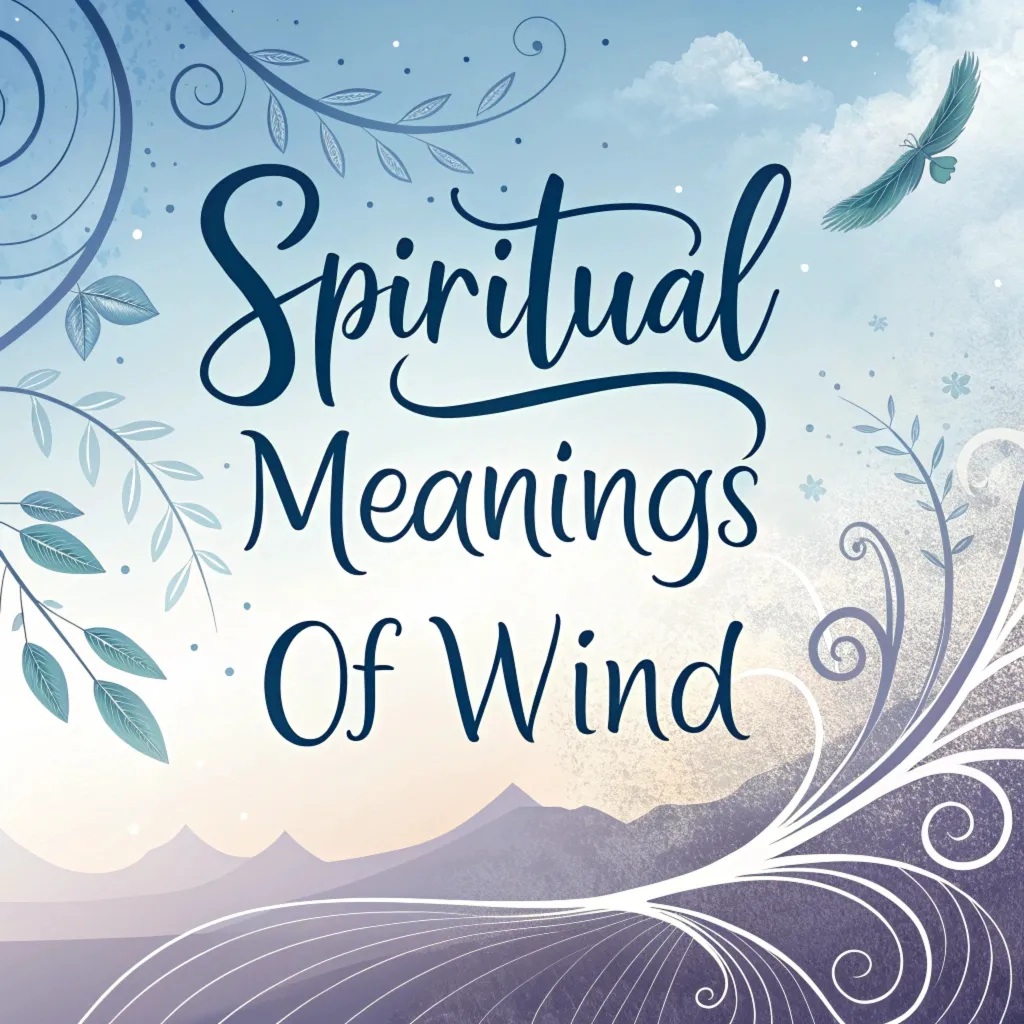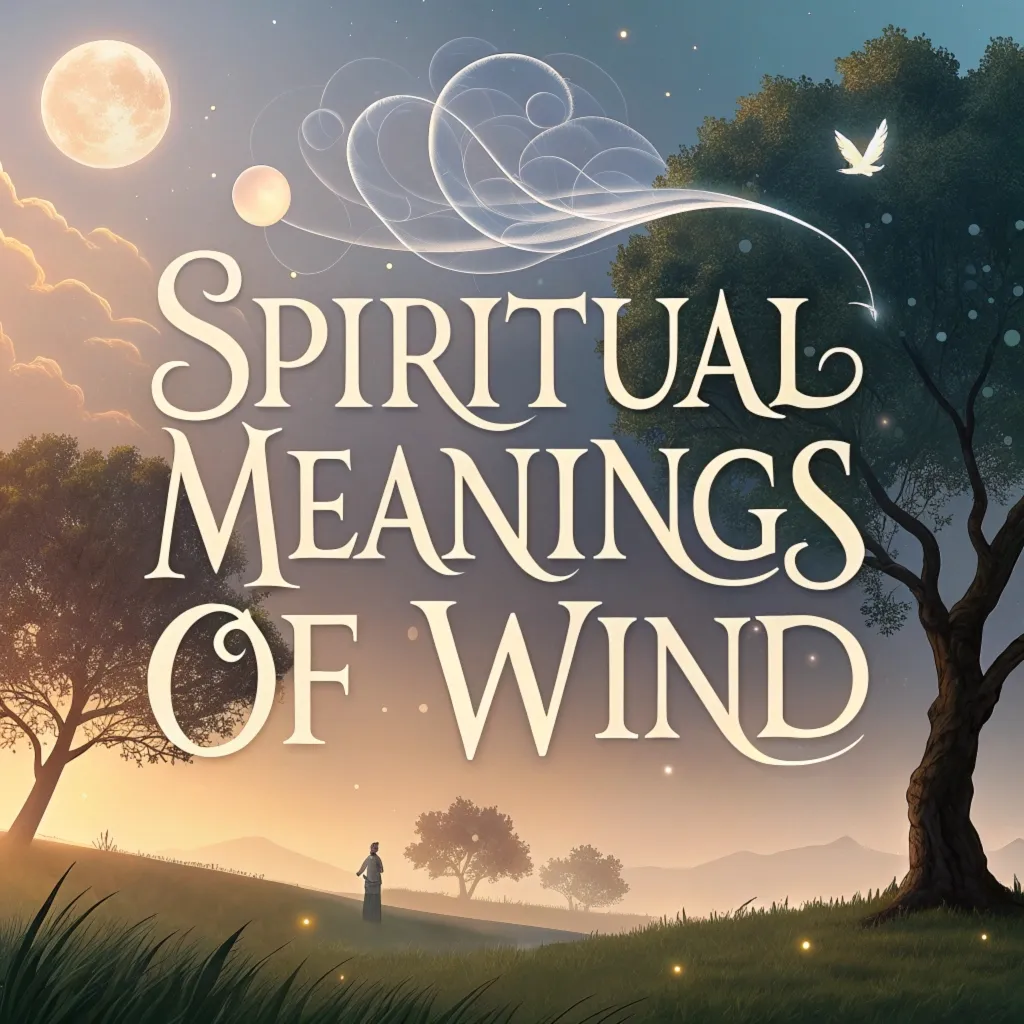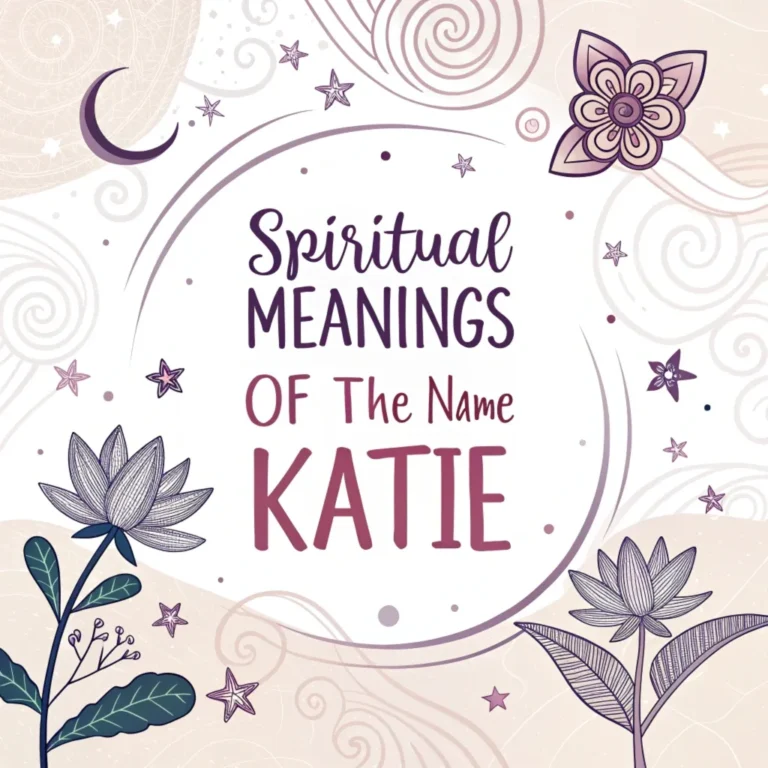13 Spiritual Meanings of Wind: A Journey Through Nature’s Whispers
The wind, a powerful force of nature, holds deep spiritual significance across cultures and beliefs.
This exploration uncovers 13 spiritual meanings of wind, revealing its role as a divine messenger, transformative agent, and symbol of life’s essence.
This article delves into the profound symbolism of wind, offering a fresh perspective on this ever-present natural phenomenon.

Key Takeaways: The Essence of Wind’s Spiritual Significance
- Divine Presence: Wind symbolizes the unseen yet tangible presence of the divine.
- Spiritual Transformation: It represents the transformative power of the Holy Spirit.
- Life Force: Wind embodies the breath of life and spiritual energy.
- Change and Renewal: It signifies transitions and new beginnings.
- Invisible Power: The wind illustrates unseen forces shaping our lives.
- Divine Communication: It serves as a medium for spiritual messages.
- Purification: Wind symbolizes cleansing of the spirit and environment.
- Freedom and Liberation: It represents breaking free from constraints.
- Divine Judgment: In some contexts, wind signifies God’s judgment.
- Spiritual Guidance: It illustrates the direction and guidance of the divine.
- Transience: Wind reminds us of life’s impermanence.
- Emotional States: It can represent various emotional and mental states.
- Cosmic Balance: Wind plays a role in maintaining spiritual equilibrium.
The Breath of the Divine: Wind as God’s Presence
Wind in spiritual contexts often symbolizes the presence of God. This invisible yet powerful force mirrors the divine nature, unseen but profoundly felt.
In many traditions, the wind represents the breath of God, a life-giving and sustaining force that permeates all creation.
The concept of wind as divine presence spans across various spiritual traditions. From the gentle breeze that comforted Elijah to the mighty wind at Pentecost, these manifestations of air in motion serve as tangible reminders of an intangible deity.
This symbolism encourages believers to seek the divine in the subtle movements of their everyday lives.
Wind’s ephemeral nature parallels the mysterious ways of the divine, reminding us that God’s presence, like the wind, can be felt but not grasped.
The Holy Spirit’s Whisper: Wind as Spiritual Transformation

The wind serves as a powerful metaphor for the Holy Spirit’s work in spiritual transformation. Just as wind can reshape landscapes, the Holy Spirit molds and changes hearts.
This transformative power is often described as a gentle breeze or a mighty rushing wind, reflecting the Spirit’s diverse ways of operation.
In many spiritual narratives, the wind symbolizes a profound change or awakening. It represents the unseen force that stirs the soul, prompting inner growth and spiritual evolution.
This transformative aspect of wind reminds us of the potential for change that resides within each individual, waiting to be awakened by the divine breath.
The Holy Spirit’s transformative power, like the wind, is both gentle and forceful, capable of subtle nudges and dramatic shifts in one’s spiritual journey.
Life’s Essence: Wind as the Breath of Life
In numerous spiritual traditions, wind symbolizes the essence of life itself. It represents the vital force that animates all living beings. This concept of wind as the breath of life underscores its fundamental role in sustaining existence, both physically and spiritually.
The connection between breath and life is a universal concept. In many creation stories, the divine breathes life into the first humans, establishing a profound link between wind, breath, and the spark of existence.
This symbolism reminds us of the sacred nature of each breath we take, connecting us to the source of all life.
Wind as the breath of life encourages a deeper appreciation for the gift of existence and the interconnectedness of all living things.
Winds of Change: Renewal and New Beginnings

Wind often signifies change and renewal in spiritual contexts. Its ability to sweep away the old and usher in the new makes it a powerful symbol of transformation. This aspect of wind reminds us of the constant flux of life and the opportunities for growth and renewal.
The concept of wind as a harbinger of change is deeply rooted in many cultures. It symbolizes the cyclical nature of existence, where endings lead to new beginnings.
This perspective encourages embracing change as a natural and necessary part of spiritual growth, rather than fearing it.
Wind’s role in renewal teaches us to welcome transformation, seeing it as an opportunity for spiritual rejuvenation and personal evolution.
The Unseen Force: Wind as Invisible Power
The wind’s invisible nature yet visible effects make it a perfect symbol for unseen spiritual forces. This concept teaches that the most powerful influences in our lives are often those we cannot see but can deeply feel and experience.
The invisible power of wind serves as a reminder of the intangible forces that shape our spiritual journeys. It encourages us to look beyond the physical realm and recognize the profound impact of unseen spiritual energies.
This symbolism invites a deeper awareness of the subtle influences in our lives and the importance of spiritual discernment.
Wind’s invisible nature reminds us to trust in forces beyond our immediate perception, fostering faith in the unseen aspects of our spiritual paths.
Divine Whispers: Wind as Spiritual Communication
Many spiritual traditions view wind as a medium of divine communication. The rustling of leaves or the howling of wind can be interpreted as messages from the spiritual realm.
This belief highlights the interconnectedness between the natural world and spiritual realms.
The idea of wind as a divine messenger encourages a heightened awareness of our surroundings. It suggests that spiritual insights can come through natural phenomena, inviting us to listen more closely to the world around us.
This perspective fosters a deeper connection with nature and the spiritual dimensions it may reveal.
Wind as communication reminds us to remain open and attentive to the subtle ways the divine might speak to us in our daily lives.
Cleansing Currents: Wind as a Purifying Force
Wind is often associated with purification and cleansing. Its ability to clear the air and disperse clouds symbolizes the spiritual cleansing of negative energies and thoughts.
This purifying aspect of wind reminds us of the importance of spiritual renewal and cleansing.
The cleansing power of wind extends beyond the physical realm. In many spiritual practices, it’s seen as a tool for clearing mental and emotional clutter.
This symbolism encourages regular spiritual cleansing, letting go of what no longer serves us, and making room for new growth and insights.
Wind’s purifying nature invites us to embrace spiritual practices that cleanse our inner landscapes, promoting clarity and renewed energy in our spiritual journeys.
Breaking Free: Wind as a Symbol of Liberation
The unrestrained nature of wind makes it a powerful symbol of freedom and liberation. In spiritual contexts, this can represent breaking free from mental, emotional, or spiritual constraints. The wind’s freedom serves as an inspiration for those seeking spiritual liberation.
Wind’s unbounded movement symbolizes the potential for breaking free from limiting beliefs and patterns. It encourages us to question self-imposed boundaries and societal constraints that may hinder our spiritual growth.
This aspect of wind inspires a journey towards greater spiritual freedom and self-realization.
The liberating symbolism of wind reminds us of the inherent freedom of the spirit and encourages us to embrace a life unbound by fear or limitation.
Divine Judgment: Wind as an Instrument of God’s Will
In some spiritual texts, wind is portrayed as an instrument of divine judgment. Strong winds or storms can symbolize God’s power and authority.
This aspect of wind reminds us of the awe-inspiring nature of divine forces and the importance of spiritual alignment.
The concept of wind as divine judgment often appears in stories of cosmic balance and moral reckoning. It serves as a reminder of the consequences of our actions and the importance of living in harmony with spiritual laws.
This symbolism encourages reflection on our choices and their alignment with higher principles.
Wind as judgment invites us to consider the broader implications of our actions and to strive for a life that resonates with divine will.
Guiding Currents: Wind as Spiritual Direction
Wind often symbolizes spiritual guidance in many traditions. Its directional nature can represent the divine leading individuals on their spiritual journeys.
This aspect of wind encourages trust in spiritual guidance and openness to divine direction.
The guiding nature of wind reminds us to remain receptive to spiritual insights and intuitions. It suggests that, like following the wind, following spiritual guidance may lead us to unexpected but meaningful destinations.
This symbolism encourages a balance between active seeking and passive receptivity in our spiritual quests.
Wind as guidance teaches us to trust the journey, even when the path ahead is not fully visible, knowing that divine direction is always present.
The Fleeting Moment: Wind as a Symbol of Transience
The ephemeral nature of wind serves as a reminder of life’s impermanence. This spiritual meaning of wind encourages reflection on the transient nature of earthly experiences and the importance of focusing on eternal truths.
Wind’s fleeting presence mirrors the temporary nature of our physical existence. It reminds us to appreciate the present moment while recognizing its impermanence.
This symbolism encourages a perspective that values spiritual growth and eternal truths over transient pleasures or challenges.
The transient nature of wind invites us to cultivate detachment from temporary circumstances and to focus on enduring spiritual realities.
Emotional Winds: Representing States of Mind
Wind can symbolize various emotional and mental states in spiritual contexts. Gentle breezes might represent peace and contentment, while strong winds could signify turmoil or passion.
This symbolic use of wind helps in understanding and expressing complex emotional experiences.
The varying intensities and characteristics of wind provide a rich metaphor for the spectrum of human emotions.
This symbolism encourages emotional awareness and the recognition that, like the wind, our feelings are constantly changing. It reminds us to observe our emotional states without becoming overly attached to them.
Wind as an emotional metaphor teaches us to navigate our inner landscapes with greater awareness and acceptance, recognizing the ever-changing nature of our feelings.
Cosmic Harmony: Wind in Spiritual Balance
In many spiritual traditions, wind plays a role in maintaining cosmic balance. It’s seen as part of the natural order that keeps the universe in harmony. This aspect of wind reminds us of the interconnectedness of all things and the importance of maintaining balance in our spiritual lives.
The balancing role of wind in nature reflects the importance of equilibrium in our spiritual journeys. It suggests that, like the wind that distributes air and moisture across the planet, we should strive for a balanced distribution of our energies and attention.
This symbolism encourages a holistic approach to spiritual growth, recognizing the need for balance in all aspects of life.
Wind’s role in cosmic harmony invites us to seek balance in our spiritual practices and to recognize our part in the greater equilibrium of the universe.
FAQs: Deepening Our Understanding of Wind’s Spiritual Significance
How does wind symbolize the Holy Spirit in Christianity?
Wind in Christianity often represents the Holy Spirit’s invisible yet powerful presence. This symbolism is rooted in biblical passages where the Spirit’s work is compared to wind, emphasizing its mysterious and transformative nature.
What role does wind play in meditation practices?
In meditation, wind or breath awareness is often used as a focal point for concentration. This practice helps in grounding the mind and connecting with the present moment, enhancing spiritual awareness.
How do Native American traditions interpret the spiritual meaning of wind?
Many Native American traditions view wind as a spiritual messenger and a manifestation of the Great Spirit. It’s often associated with wisdom, change, and the breath of life in these cultures.
Can wind have different spiritual meanings based on its direction?
Yes, in various traditions, winds from different directions carry distinct spiritual meanings. For example, east winds might symbolize new beginnings, while west winds could represent endings or introspection.
How is wind used in spiritual cleansing rituals?
Wind is often incorporated in spiritual cleansing rituals as a purifying force. This can involve using fans, feathers, or natural wind to cleanse spaces or individuals of negative energies.
What does a strong wind symbolize in spiritual contexts?
Strong winds often symbolize significant spiritual events or divine intervention. They can represent powerful transformations, spiritual awakenings, or moments of profound change in one’s spiritual journey.
How does the concept of wind relate to spiritual breathing exercises?
Spiritual breathing exercises often draw parallels with wind, focusing on the flow of breath as a representation of life force or spiritual energy. These practices aim to enhance spiritual connection and promote inner peace.
What is the significance of wind in feng shui?
In feng shui, wind is considered a carrier of chi or life energy. Proper wind flow is believed to promote positive energy in living spaces, contributing to overall well-being and spiritual harmony.
How do different religions interpret the sound of wind?
Various religions interpret wind sounds differently. Some see it as divine whispers, while others interpret it as nature’s music. The interpretation often depends on the context and the specific spiritual tradition.
Can wind be used as a tool for spiritual divination?
Some spiritual practices use wind patterns or sounds for divination purposes. This might involve interpreting wind direction or intensity as signs or omens to gain insight into spiritual matters or future events.

Susan is the founder of Soulful Meanings, a platform dedicated to exploring spiritual concepts and meanings. Susan believes in the power of understanding spiritual symbols and practices to foster connection and self-discovery. Through her writing, she aims to inspire others to embrace their unique paths and deepen their spiritual awareness.







